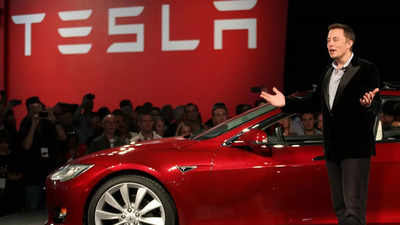- News
- Technology News
- Tech News
- Did Elon Musk start Tesla? The truth behind his rise to the top
Trending
Did Elon Musk start Tesla? The truth behind his rise to the top
Tesla, the electric vehicle giant, was founded by Martin Eberhard and Marc Tarpenning in 2003. Elon Musk joined in 2004 as an investor. He later became a co-founder through a legal settlement. Musk then actively promoted himself as the visionary leader. Public perception now largely credits Musk with founding Tesla. The narrative highlights how influence can shape business history.
Elon Musk is widely recognized as the face of Tesla, the electric vehicle (EV) giant known for redefining modern transportation. From high-profile product launches to bold predictions about sustainable energy, Musk is often viewed as the founder of the company. However, historical records reveal that Tesla was actually founded by engineers Martin Eberhard and Marc Tarpenning in 2003, before Musk joined the venture. Below you can read how Musk, through a combination of strategic investments, public relations, and legal decisions, successfully positioned himself as a co-founder of Tesla. The transformation of Tesla's founding narrative offers an illustrative example of how perception, legal frameworks, and media influence can shape public memory and business history.
Elon Musk is not the real co-founder of Tesla
Tesla Motors was founded in July 2003 by Martin Eberhard and Marc Tarpenning, two engineers and entrepreneurs with a vision to produce fully electric vehicles that could rival traditional combustion-engine cars in performance and design. The company was named after Nikola Tesla, the 19th-century inventor known for his work in electricity and electromagnetism.
The initial objective of Tesla was to build a high-end sports car using lithium-ion battery technology, something that had not been achieved successfully at the time. Eberhard and Tarpenning funded the early stages of the company themselves and had already developed a detailed business plan and technical foundation for their concept.
When Elon Musk joined Tesla: The 2004 investment that changed everything
Elon Musk entered the Tesla narrative in February 2004 by leading the Series A investment round. He contributed $6.5 million of the $7.5 million raised, making him the company’s largest shareholder and the chairman of the board. Musk had already made a name for himself as a tech entrepreneur through ventures such as Zip2 and X.com, which later became PayPal.
Though not a founder, Musk played an influential role early on. He contributed to product development discussions, branding decisions, and long-term vision strategies. His growing involvement and financial stake gave him significant leverage in shaping the company’s future.
When Elon Musk claimed Tesla’s vision as his own
Initially, Martin Eberhard was recognized as the public face of Tesla. He was frequently quoted in interviews and appeared in media campaigns, including one notable ad in which he was portrayed in a style reminiscent of Steve Jobs. At this time, Elon Musk remained largely in the background, despite his financial influence.
As Tesla began to gain recognition in the media, Musk became concerned about his lack of visibility. Internal emails from this period reportedly indicate Musk’s dissatisfaction with the coverage and his desire to be more prominently associated with Tesla’s identity and vision. In 2006, Musk took a major step to change that by publishing the “Top Secret Tesla Motors Master Plan” blog post. This document outlined Tesla’s long-term strategy and positioned Musk as the architect of the company's direction, even though the core ideas had been established by the original founders.
Elon Musk’s role in Eberhard’s removal at Tesla
As Tesla moved into production of the Roadster, internal disagreements between Eberhard and Musk intensified. Disputes arose over deadlines, budgets, and managerial styles. Musk’s approach was known to be highly demanding, and eventually, these tensions culminated in Eberhard’s removal as CEO in August 2007. Though the company cited performance reasons, many viewed it as a strategic move by Musk to consolidate power.
Eberhard was later officially removed from the company’s leadership and board, marking a turning point in Tesla's leadership dynamics. Following his departure, he filed a defamation lawsuit against Musk in 2009, alleging that Musk had spread false information and was attempting to erase his contributions to Tesla’s founding.
How a legal settlement made Elon Musk Tesla’s official co-founder
The legal dispute between Eberhard and Musk was settled out of court. A key outcome of the settlement was that Musk, along with several others including JB Straubel and Ian Wright, was granted the legal right to use the title of "co-founder" of Tesla. This agreement effectively allowed Musk to publicly and officially call himself a co-founder, despite not being part of the initial formation of the company in 2003.
How Musk reinforced his identity as Tesla’s visionary leader
Following the legal resolution, Musk actively reinforced his identity as Tesla’s founder. His numerous public speeches, interviews, and company statements consistently positioned him as the visionary who built Tesla from the ground up. The company’s own press releases and website began to reflect this narrative, with Musk often being introduced as a co-founder.
Several strategies contributed to this solidification:
- Media management: Musk’s active presence on platforms like Twitter and in major news outlets helped him steer public discourse.
- Public appearances: By front-lining product launches, delivering keynote addresses, and participating in technology forums, Musk maintained a high visibility.
- Narrative ownership: Tesla’s communication and branding materials consistently framed Musk as the central figure behind the company’s innovations and success.
The broader impact on public memory
Today, most people associate Tesla with Elon Musk, rarely mentioning Eberhard or Tarpenning. While industry insiders and historians acknowledge the contributions of the original founders, the broader public perception credits Musk with founding the company. This phenomenon underscores how public memory can be influenced more by narrative control and visibility than by factual chronology.
Musk’s role in Tesla is undeniable in terms of scaling the company, securing funding, and guiding its strategy during critical phases. However, the distinction between founding a company and transforming it is significant, and in Tesla’s case, these roles were played by different individuals at different times.
Also read | Genshin Impact Codes | Fruit Battlegrounds Codes | Blox Fruits Codes | Peroxide Codes

About the Author
TOI Tech DeskEnd of Article
Latest Mobiles
Follow Us On Social Media









